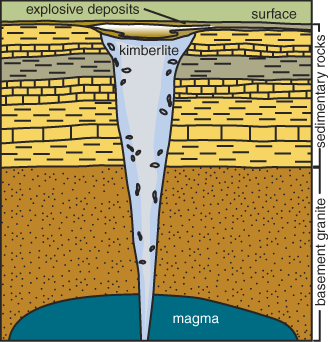Kimberlite Cliff
We spent the first part of yesterday looking at core samples – lots and lots of core samples. I’ll upload some photos as soon as I get back to civilization. The drillers circled garnets and other indicator minerals on the surface of the cores. These cores will be crushed and used in a “mini-bulk” sample, which will be tested for microdiamond content (after all that crushing, the only diamonds you’re likely to find are “micro.”
In the afternoon, we waited for a break in the rainy and foggy weather. Then it was back in the helicopters (cue the Ride of the Valkeries) for a ride out to an active drill rig. After that, we flew off for a longer flight, over a weird lunar landscape composed of clay deposits left by old rivers that I told you about yesterday, to finally land on a rocky cliff or bluff. The geologist led me down the adjoining slope to get a better look at the bluff.
“I wanted to show this to you,” he said. “It’s something special.”
The face of the bluff is all kimberlite. Now, it may or may not be diamondiferous – we don’t know that yet, and even if it is diamondiferous, we don’t know if it’s economically viable. But the geologist explained this is probably the only place in North America – and maybe
Remember, diamonds are formed deep under the earth’s surface, in the mantle, about 90 miles or so down. There, they lie in wait for a volcanic eruption to bring them to the surface. Problem is, most volcanoes don’t form that deep. Hence, we have the first factor in what makes diamonds so rare.
When a volcano does form that deep under that kind of pressure, it’s usually pissed off enough to spike higher in a cone or “volcanic pipe”. A second factor making diamonds so rare is that diamond-bearing volcanic pipes are closely related to the oldest, coolest regions of continental crust (cratons). This is because cratons are very thick, and their mantle extends to great enough depth that you have stable conditions for diamond formation.
And here I can make another point – not all volcanic rocks contain a lot of diamonds, or are diamondiferous, in rock hound lingo.
So anyway, the magma carries this old rock upward. The kind of old rock we’re interested in is kimberlite, specifically kimberlite that is saturated with “indicator minerals” -- magnesium-bearing olivine, pyroxene, magnetite, garnet and others.
It’s important to know that indicator minerals form at the same depth as diamonds, so they indicate that the kimberlite MAY contain diamonds. But finding garnets does NOT necessarily mean you’ll find diamonds. Still, indicator minerals get geologists excited, because they’re figuring “where there’s smoke, there’s fire.”
So, there is this big ol’ bluff of kimberlite, a rare find in a weird landscape. Maybe it has diamonds, maybe it doesn’t. Maybe mining those diamonds would be economically viable, maybe not. There are a lot of unanswered questions out here in the
While I was stumbling over the kimberlite, I found a baby caribou skull. The day before that, I found a caribou antler. I wonder what part of the beast I’m going to find today, eh?
We did see live caribou on our way back. We came back to a feast put on by the camp’s chef. Mining camps have the best food in the world, and our chef, Dominic, wasn’t going to be outdone. I ate a huge dinner of roast caribou with gravy, caribou stew, baked char (an Arctic fish), Greek salad, vegetables and a huge slice of strawberry shortcake AND two slices of bread. I ate the second slice of bread because I had a small fish bone lodged in my throat (ack). I need to get out of this camp for my waistline’s sake, lol.
The caribou stew was the absolute best. I’d ask for the recipe, but where am I going to find caribou again? It’s not like they carry it at the local supermarket.
For lunch today, we’re supposed to get a local delicacy, whale blubber, which I’m spelling phonetically as “Maktaa.” Mmm-mm good!
Then last night, as the rain drummed on the roof of the Weatherhaven, I watched “The Big Lebowski” on a notebook computer with a couple of friends. The movie was great. John Goodman chews up the scenery, Jeff Bridges* is marvelously mellow as the film’s star, the supporting cast is top-notch and the script takes more twists and turns than a Chinese puzzle box.
I don’t know what the schedule is today. Tonight we fly back to


<< Home